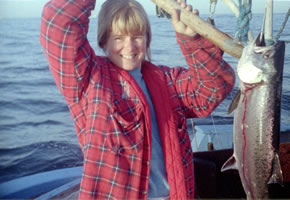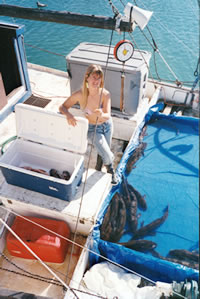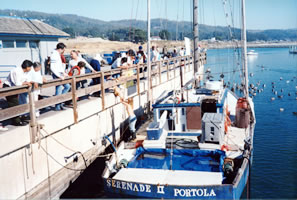 My
first trip out on a commercial boat, the Anna
B, played out the way I’d learn it often
does for salmon trollers. After months of preparation
at the dock, sanding, painting, and making gear,
the opening day of salmon season looms just
around the corner. For a week, you’ve
been negotiating a price for your fish, along
with a bunch of other vessels, and hoping none
of the others decide to go out on strike. At
some point during the final 48 hours [weather
permitting], you jockey for position
at the crowded fuel dock to gas up and blow
ice into the hold. The chaos is like a shopping
mall the day before Christmas. There’s
one last chance to raid the grocery store before
throwing the lines. You head out a couple hours
either side of midnight [weather
permitting] to get to the fishing grounds
by dawn. Buddy boats team up and do their radio
checks using this year’s secret codes.
You leave the jaws of the harbor on your way
to filling your hold with fish (you hope). At
first light [weather
permitting], you send the gear into the
depths, cross your fingers, and say a prayer
or two. As the day unfolds, your prayers are
answered. You couldn’t have asked for
better weather or a calmer ocean.
My
first trip out on a commercial boat, the Anna
B, played out the way I’d learn it often
does for salmon trollers. After months of preparation
at the dock, sanding, painting, and making gear,
the opening day of salmon season looms just
around the corner. For a week, you’ve
been negotiating a price for your fish, along
with a bunch of other vessels, and hoping none
of the others decide to go out on strike. At
some point during the final 48 hours [weather
permitting], you jockey for position
at the crowded fuel dock to gas up and blow
ice into the hold. The chaos is like a shopping
mall the day before Christmas. There’s
one last chance to raid the grocery store before
throwing the lines. You head out a couple hours
either side of midnight [weather
permitting] to get to the fishing grounds
by dawn. Buddy boats team up and do their radio
checks using this year’s secret codes.
You leave the jaws of the harbor on your way
to filling your hold with fish (you hope). At
first light [weather
permitting], you send the gear into the
depths, cross your fingers, and say a prayer
or two. As the day unfolds, your prayers are
answered. You couldn’t have asked for
better weather or a calmer ocean.
The Anna B went on to land 73 salmon that first
day (actually, 73½ if you count the front
half of a 20-pounder that got bit cleanly though
by a white shark while it was on the line).
Over the next four days we filled the hold and
turned the boat back to port. By the end of
that trip, I was hooked as well!
In the years that followed, I fished on many
different boats for a variety of species. My
travels took me from California to Washington,
and then on to Alaska and Hawaii. I sportfished
whenever I got the chance, and even served as
deckhand on some party boats occasionally. Yet
I’ll never forget the good old days, fishing
in front of the bait receiver at the Pavilion,
spending weekends at Catalina Island, or running
out of gas in the Glasspar and getting towed
back to port from Huntington Flats.
*****************
If you’ve had a
successful day at sea, I will only remind you
of two things: clean it and ice it as soon as
possible! I like to use a wooden cutting board
to fillet or to steak fish. If they’re
big fish, I use a sheet of plywood. Try not
to soak the fish with water while you are cleaning
it. Rinse it lightly, or just wipe off small
bits of shmutz with your fingers or paper towel.
Then, put it in plastic bags and lay it out
on ice. Don’t dump a lot of heavy ice
on top of your beautiful fish! When I’m
done, I rinse the board off with cold water
first and then spray it with a bleach and water
solution. I follow that with a good soap and
hot water washing. I also use the same bleach
solution to spray out the ice chest I used to
carry the fish home. It’s what works best
at getting the fish smell out.
For the rest of you who are stalking your prey
through the glass (at the market), pay attention.
Your best bet is to buy fish locally when in
season, right off the boat when possible. You
will not only get a fresh fish, but an education
to go with it. Most fishermen love to tell people
about their boats and catch. Just try to avoid
the topics of politics or fishing regulations,
and you should do ok!
Your best bet for a year-round supply, especially
when looking for exotics, will be an upscale
market or seafood store. Depending on where
you live, some seafood restaurants will also
sell fish to their customers. Try to shop for
fresh fish close to the weekend, as that is
when most suppliers deliver the new orders.
Do not buy fish that looks dry or off-colored.
The smell shouldn’t be overpowering either.
Prime flatfish are often displayed belly-up
to show off the condition of the fish. If you
wish to purchase one displayed eyes-side-up,
be sure to first flip it over to check for bruising.
I often take along a small cooler with blue
ice when I go shopping, in case I happen to
run across something good. This also comes in
handy for cheese and ice cream, if you live
in the boonies, like I do.
When you do find a nice supply of fish at a
good price, you may wish to buy some extra and
to freeze it for future use. This works out
especially well with whole fish, such as salmon
or large halibut. I will often steak the front
half of the fish and fillet the back. I use
two methods of packaging. For short term freezing,
I like to use a freezer quality airtight Ziploc
bag, and I remove as much air from the bag as
possible before sealing it. If I’m storing
fish in the deep freeze for a while, I vacuum
seal it. An affordable vacuum packer, such as
FoodSaver, can be found in stores or over the
internet and is a good idea if you get into
cooking or catching a lot of fish.
*****************
Whatever I’ve chosen
for a recipe is, in my opinion, the best possible
fish for that particular recipe; that is, of
all the species I’ve tasted so far. In
most cases, I have added suggestions for alternative
fish substitutions. If you want to try an alternative
species, try to get it in the same form. That
is, if a recipe calls for a halibut fillet,
2-3 inches thick, and you want to use Chilean
seabass instead, just make sure to use a fillet
that’s about 2-3 inches thick as well.
For the health-conscious, the three fish highest
in omega-3 fatty acid content in this book are
Chilean seabass, salmon, and bluefin tuna.
Leave
the skin on your fish if it came that way, in
case you choose to use a cooking method that
requires it. You can always remove it later
if it is not needed.
Fresh
fish should be stored in the refrigerator or
left on ice for use within one to two days,
for best flavor. If you notice liquid collecting
around the fish during this time, drain it off
and pat the fish dry with paper towel. If you
like sashimi, I recommend the tuna species or
yellowtail (hamachi). This is best when kept
fresh on ice, especially while still on the
boat. I have known people who keep wasabi in
their tackle boxes!
*****************
 Most
of the time, we engaged in “live”
fisheries, which meant that you had to subdue
a ling, sometimes up to 40 pounds, and wrestle
a jig out of his mouth before throwing him in
a tank. Every now and then, you’d go stir
the tank so that some poor fish pinned in a
corner could move and start using his gills
again. As I mentioned, they’re hard to
kill. We could keep between 500 and 1800 pounds
of fish alive to sell back at the dock.
Most
of the time, we engaged in “live”
fisheries, which meant that you had to subdue
a ling, sometimes up to 40 pounds, and wrestle
a jig out of his mouth before throwing him in
a tank. Every now and then, you’d go stir
the tank so that some poor fish pinned in a
corner could move and start using his gills
again. As I mentioned, they’re hard to
kill. We could keep between 500 and 1800 pounds
of fish alive to sell back at the dock.
If
the weather permitted, we’d fish a couple
days before the weekend and be back at the harbor
selling the fish Saturday morning. We would
fill our display tank on the deck with a bunch
of lings, and people would wander over to the
rail beside the boat to make their selections.
Half of the customers would have a certain size
fish in mind. I’d search the tank for
the right size fish, haul it out with my short-handled
gaff hooked under its gill plate, and hang it
on the scale. If the buyer liked the weight,
I’d lay the fish out on the deck and proceed
to bludgeon it to death with the gaff handle,
to the delight of the cheering crowd. We’d
slide the fish into a brown paper bag (“body
bag”), then hoist it in a bucket up to
the customer on the dock. This show came to
be known around Pillar Point Harbor as, “The
Lady and the Lingcod.”

Excerpts
taken from the introductory chapter (“Hooked
on Fishing”), Cooking Basics (“Caught
it vs. Bought it”), and the intro to the
Lingcod chapter.

